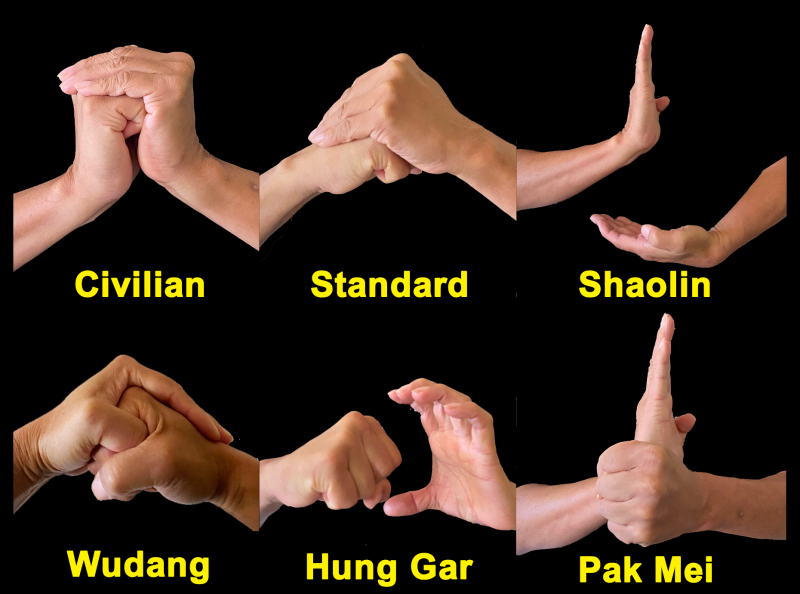Subscribe
Subscribe to our quarterly email newsletter 「ICM News」 to receive recent news about ICM, diverse writings by experts and youth, and relevant information.
Title [Martial Arts Globe] Variation in Salutes within Chinese Martial Arts

Photo provided by the author. Variation in
Salutes within Chinese Martial Arts By Gene Ching Bowing is one of
the most important gestures in the martial arts. It opens and closes the
practice space with a promise to be courteous and respectful to your school and
fellow practitioners. The prevalent Korean and Japanese styles use a simple bow
where the upper body leans forward at the waist. In contrast, within the Chinese
styles a bow is supplanted by a salutation gesture – commonly this is expressed
with the left hand covering the right fist. There are variations and layers of
meaning within the Kung Fu salute worth examination as they reveal the
complexity behind the simplest of gestures. The covered fist
salute dates to the Zhou Dynasty (1046-771 BCE) however this is form is
traditional etiquette for all Chinese where the wrists are held close together
(Top China Travel, 2015). This civilian bow differs from martial arts salute
where the wrists are not bent so the forearms are in line with the fist and
hand. The right hand makes the fist, and the left hand covers it. It is
preferable to the handshake for martial artists because there are many ways to
attack from there. The International
Wushu Federation standardized a salute for competition. It is defined in the
first point of Protocol of Wushu Taolu Competition as so: “Fist-Palm Salute
- In a standing position with feet together, place the right fist against the
upright left palm, with the former’s knuckles at the root of the latter’s
fingers, in front of and 20-30cm away from the chest” (IWuF, 2005, p.62). There are several
interpretations of the martial salute. The hand-covering-fist may represent
martial strength (the fist) being restrained by wisdom (the open hand), akin to
China’s prevalent scholar warrior notion. The covered hand may also symbolize
the crescent moon (月)
while the fist represents the sun (日). The shape of the hands echoes the
Chinese characters, so much so that some Chinese practitioners refer to the
‘Sun’ fist (Ching, G, 2010). In Chinese, combining the characters for sun and
moon means ‘bright (明)’
which is the name of the Ming Dynasty (1368-1644 CE). The Ming is venerated as
a high point of Chinese culture (Pang, 2022, p.11; Oh, G., and Ching, G, 2003,
p.85-86). Variant Salutes While the covered
fist is a standard salutation within the Chinese martial arts circles, there
are variations within many of the different sects. Secular practitioners of styles
like Shaolin (少林), Wudang (武當),
Hung Gar (洪家), and Pak Mei (白眉)
have unique salutes, each with their own meaning. Disciples of
Shaolin Temple have a unique salute without a fist. Shaolin is Buddhist so they
generally adopt a Buddhist bow with both palms pressed together in front of
their hearts for a salutation gesture. However, Shaolin disciples sometimes do
this with only one hand. This is in honor of Huike, the first disciple of the founder
of Zen and Kung Fu, Bodhidharma. Legend tells of how Bodhidharma rejected
Huike’s request to become a disciple until the ‘snow becomes red.’ In response,
Huike cut off his left arm to show his resolve (Ching, 2010, p.58). In honor of
Huike’s commitment, Shaolin followers perform a Buddhist bow using only the
right hand. In contrast,
disciples of Wudang Temple are Daoist. Shaolin is classified as ‘external’ or
‘hard’ while Wudang is ‘internal’ or ‘soft.’ Externally, the Wudang salute
looks like the standard martial salute. However, Wudang followers make their
fist wrap around their left thumb. This forms a tiny yin yang pattern that only
the saluting person can see. It reflects the internal and esoteric nature of
Wudang as well as the devotion to Daoism where the yin yang is a prominent
symbol (Ching, 2002, p.11). In the southern
Chinese style of Hung Gar, the right hand is still held in a fist but the left
hand changes to a tiger claw. The tiger claw is a predominant hand used for
attack in this style. The hands do not touch (Lam, 2003, p.22). This salutation
is accompanied by two steps forward and two steps backward. Despite the notion
that the salute is less aggressive than a handshake, there are also many hidden
combat applications in the Hung Gar salute (Tiger Crane Kung Fu, 2007). The salute in Pak
Mei Kung Fu has a vertical right palm atop an upright left fist. The five
clenched fingers of the left hand symbolize the five major lakes of China while
the four fingers of the right palm stand for the four seas surrounding China. As
Sifu Williy Pang describes it “The
notion of 5 lakes and 4 seas implies an all-encompassing idea of kinship among
the inhabitants of China, hence, a universal unity.” (Pang, 2022,
p.12).
There are more salutation variations than these but that is beyond the scope of this article. This is just a sampling to demonstrate the diversity of the martial arts, as well a few of the hidden meanings behind common expressions of the art. Within authentic martial arts, every gesture has meaning, and it is important to preserve these meanings lest the intention behind the arts become lost. Reference
※ Views in this writing are the author's own. |
















